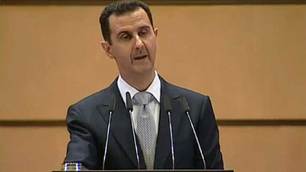SPACE
Humans in space
Canada's astronauts
Last Updated: Tuesday, October 26, 2010 | 2:51 PM ET
CBC News
IN DEPTH: Humans in space
- Canada's astronauts
- Eight astronauts and one space tourist
- Exploring ISS
- Robert Thirsk
- Shuttle landings
- Civilians in space
 Canada's eight astronauts, posing for a photo at the John H. Chapman Space Centre in St. Hubert, Que., in 2003: Back row, left to right, Marc Garneau, Steve MacLean, Julie Payette, Dave Williams; front row, left to right, Roberta Bondar, Chris Hadfield, Robert Thirsk and Bjarni Tryggvason. (Andre Pichette/Canadian Press)
Canada's eight astronauts, posing for a photo at the John H. Chapman Space Centre in St. Hubert, Que., in 2003: Back row, left to right, Marc Garneau, Steve MacLean, Julie Payette, Dave Williams; front row, left to right, Roberta Bondar, Chris Hadfield, Robert Thirsk and Bjarni Tryggvason. (Andre Pichette/Canadian Press)
Nine Canadians have flown into space — eight trained astronauts and one civilian. Canadians have flown on 13 manned NASA missions and two Russian Soyuz missions.
The next Canadian in space will be Chris Hadfield when he launches aboard a Soyuz capsule in December 2012. Hadfield will become the first Canadian to command the International Space Station.
Here's a look at what each accomplished in space, and where they are today.
Marc Garneau
 Marc Garneau. the first Canadian in space, is now a Liberal MP and the party's science, industry and technology critic. (Fred Chartrand/Canadian Press) Years in space: 1984, 1996, 2000
Marc Garneau. the first Canadian in space, is now a Liberal MP and the party's science, industry and technology critic. (Fred Chartrand/Canadian Press) Years in space: 1984, 1996, 2000
Hometown: Quebec City
Canada's first astronaut, Garneau was a member of the 1984 Challenger crew and performed a series of experiments, called CANEX, sponsored by the Canadian government.
Garneau returned to orbit in 1996 and 2000 on Endeavour, becoming the only Canadian to make three journeys to space. In 2000, he used the shuttle's Canadarm to install the first four solar panels on the International Space Station. In total, he logged 677 hours in space.
Garneau was president of the Canadian Space Agency from 2001 to 2005. In 2006, he ran unsuccessfully for federal office as a Liberal candidate in the rural Quebec riding of Vaudreuil-Soulanges, but won in the downtown Montreal riding of Westmount-Ville-Marie in 2008. He is currently the Liberals' science, industry and technology critic.
- Garneau marks 25 years of Canadians in space
- Q&A: Garneau's next mission: bring science to politics
- CBC Archives: Astronaut Marc Garneau soars into history (March 14, 1984)
- CBC Archives: Live from space (Oct. 9, 1984)
- CBC Archives: Happily back in the Heavens (May 20, 1996)
- CBC Archives: The final mission (Dec. 3, 2000)
Roberta Bondar
 Canadian astronaut Roberta Bondar now keeps a busy schedule giving conferences on space and medicine. (Courtesy Roberta Bondar) Year in space: 1992
Canadian astronaut Roberta Bondar now keeps a busy schedule giving conferences on space and medicine. (Courtesy Roberta Bondar) Year in space: 1992
Hometown: Sault Ste. Marie, Ont.
Neurologist Bondar became Canada's first woman in space when she flew on the shuttle Discovery on Jan. 22, 1992. Bondar performed research into the effects of microgravity, lower body pressure and various pathological states on blood flow to the brain. She retired from the Canadian Space Agency later that year to continue her research while pursuing other ventures, including public speaking and photography. She served as chancellor of Trent University in Peterborough, Ont., from 2003 to 2009.
- Q&A: Roberta Bondar
- CBC Archives: Roberta Bondar is out of this world (Jan. 22, 1992)
Steve MacLean
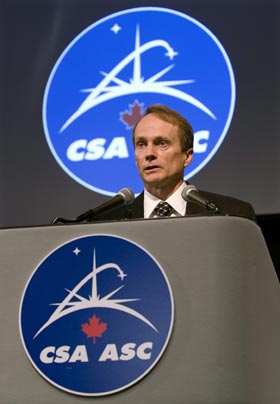 Former astronaut Steve MacLean addresses a news conference after being named the new head of the Canadian Space Agency. (Paul Chiasson/Canadian Press) Years in space: 1992, 2006
Former astronaut Steve MacLean addresses a news conference after being named the new head of the Canadian Space Agency. (Paul Chiasson/Canadian Press) Years in space: 1992, 2006
Hometown: Ottawa
Laser physicist MacLean began astronaut training in 1984 and was scheduled to first go into space aboard Atlantis in 1987. That mission was cancelled after the Challenger disaster.
MacLean first flew aboard space shuttle Columbia in 1992, when he performed a set of experiments called CANEX-2. Among those experiments was the Space Vision System, an experimental machine vision system to help astronauts guide robotic devices, such as the Canadarm.
MacLean was the project manager for designing similar "eyes" for both the shuttle's Canadarm and the International Space Station's Canadarm 2.
MacLean was set to go into orbit again in 2003 aboard Endeavour until the shuttle fleet was grounded after Columbia broke into pieces on Feb. 1 of that year, killing all seven astronauts aboard. He returned to space in 2006 aboard Atlantis as a member of the first space-station assembly mission since the Columbia disaster. He became the first Canadian to operate the Canadarm 2 in orbit and performed a seven-hour spacewalk to activate the station's solar panels.
MacLean was appointed president of the Canadian Space Agency in September 2008.
- Atlantis soars into orbit with Canadian Steve MacLean on board
- Canadian spacewalker: "Boy, am I ever high"
- Steve MacLean named head of space agency
 Canadian Space Agency astronaut Chris Hadfield pilots a tiny, one-person submarine in Pavilion Lake near Lillooet, B.C., in July 2010. Hadfield collected rock samples and took photos and videos of the unusual rock formations, called microbialites, deep beneath the lake's surface. (Pavilion Lake Research Project)
Canadian Space Agency astronaut Chris Hadfield pilots a tiny, one-person submarine in Pavilion Lake near Lillooet, B.C., in July 2010. Hadfield collected rock samples and took photos and videos of the unusual rock formations, called microbialites, deep beneath the lake's surface. (Pavilion Lake Research Project)
Chris Hadfield
Years in space: 1995, 2001
Hometown: Born in Sarnia, Ont., raised in Milton, Ont.
Veteran test pilot Hadfield made his first shuttle flight aboard Atlantis, becoming the first and only Canadian to board the Russian space station Mir. Hadfield returned to space on April 20, 2001, to make history by becoming Canada's first astronaut to walk in space. His second spacewalk of that mission took seven hours and 40 minutes to make repairs to the space station. He also became the first Canadian to operate the Canadarm 2 in space. Hadfield later told CBC News that conducting a spacewalk was a gruelling physical ordeal.
"If you could picture it, you first put on a suit of armour and then go jump in a lake and then perform the task. That's what it is like. You have to be strong and fit," he said.
Hadfield served as NASA's chief of International Space Station operations from 2006 to 2008. He trained as a backup for Robert Thirsk for his long-duration stay aboard the station.
Hadfield will begin a six-month mission aboard the ISS in December 2012 and will command the station during the second half of that mission. He will be the first Canadian to command the ISS.
- Hadfield named space station commander
- Astronauts explore space science in B.C. lake
- CBC Archives: A Canadian reaches the arm (Nov. 9, 1995)
Robert Thirsk
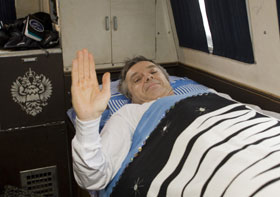 Canadian astronaut Bob Thirsk waves as he rests inside a vehicle of the Russian Space Agency following his landing in December 2009 in northern Kazakhstan after six months in orbit. (Shamil Zhumatov/Associated Press) Years in space: 1996, 2009
Canadian astronaut Bob Thirsk waves as he rests inside a vehicle of the Russian Space Agency following his landing in December 2009 in northern Kazakhstan after six months in orbit. (Shamil Zhumatov/Associated Press) Years in space: 1996, 2009
Hometown: New Westminster, B.C.
Thirsk flew as a payload specialist aboard space shuttle Columbia's Life and Microgravity Spacelab mission. During the 17-day flight, he and six crewmates performed 43 experiments, some devoted to the study of changes in plants, animals and humans under space-flight conditions. Thirsk also trained as backup crewmember for a Russian Soyuz mission in 2005, the first Canadian astronaut to do so.
Thirsk became the first Canadian to complete a long-term stay in space when he lived aboard the International Space Station for six months in 2009. During his stay, Thirsk welcomed two other Canadians to the station, fellow astronaut Julie Payette and space tourist Guy Laliberté. The meeting of Thirsk and Payette on the ISS in July was the first time two Canadians met in space.
Thirsk has also used the station's robotic arm, Canadarm 2, to assist in the station's construction. In September, he assisted in the arm's capture of a Japanese cargo vessel, the first-ever capture of a free-flying spacecraft. He called "the first Canadian cosmic catch" the most exciting moment of his mission. Thirsk was also the first Canadian to launch and land aboard a Russian vessel.
Thirsk announced in October 2010 that his 2009 mission would be his last in space, and it was time to make room for the country's two newest astronauts, Jeremy Hansen and David Saint-Jacques.
- No more space travel for Thirsk
- Astronaut Thirsk lauds space investment
- Astronaut Thirsk back on Earth
- Thirsk's Canadian experiments in space
Bjarni Tryggvason
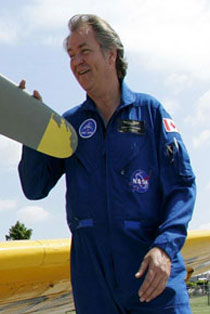 Canadian astronaut Bjarni Tryggvason left the Canadian Space Agency in June 2008 after almost 25 years as an astronaut. (Dave Chidley/Canadian Press) Year in space: 1997
Canadian astronaut Bjarni Tryggvason left the Canadian Space Agency in June 2008 after almost 25 years as an astronaut. (Dave Chidley/Canadian Press) Year in space: 1997
Hometown: Born in Reykjavik, Iceland, grew up in Richmond, B.C.
Tryggvason was one of the six Canadian astronauts selected in December 1983. He flew as a payload specialist in August 1997, aboard the space shuttle Discovery. On the mission, he performed fluid-science experiments of his own design to test how spacecraft vibrations affected other station experiments. He also designed a similar experiment that operated on the Russian Mir space station.
He retired from the Canadian Space Agency in June 2008 and is now a visiting professor at the University of Western Ontario in London. He has written more than 50 published papers and holds three patents.
Dave Williams
Years in space: 1998, 2007
Hometown: Born in Saskatoon, grew up in Montreal.
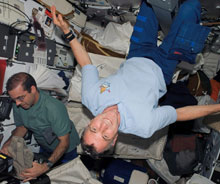 Canadian astronaut Dave Williams, right, and astronaut Rick Mastracchio are shown on the space shuttle Endeavour in 2007. (NASA/Canadian Press/Associated Press) Dafydd (Dave) Williams first flew on the space shuttle on April 17, 1998, where he participated in Neurolab, a 16-day mission aboard Columbia. The mission was dedicated to the advancement of neuroscience research, directing its attention to the effects of weightlessness on the nervous system.
Canadian astronaut Dave Williams, right, and astronaut Rick Mastracchio are shown on the space shuttle Endeavour in 2007. (NASA/Canadian Press/Associated Press) Dafydd (Dave) Williams first flew on the space shuttle on April 17, 1998, where he participated in Neurolab, a 16-day mission aboard Columbia. The mission was dedicated to the advancement of neuroscience research, directing its attention to the effects of weightlessness on the nervous system.
As a member of Endeavour's crew in 2007, Williams made three spacewalks during a 12-day mission, the most by a Canadian. During that time, spent nearly 18 hours outside in space assembling the International Space Station, breaking the previous Canadian mark by colleague Chris Hadfield.
Williams retired from the CSA in 2008 and became director of the McMaster Centre for Medical Robotics at the St. Joseph's Healthcare facility in Hamilton, Ont.
- Canadian astronaut's spacewalk a success
- Ex-astronaut lands as McMaster medical robotics director
- Canuck astronaut Williams recounts 'spectacular beauty'
 Canadian Space Agency astronaut Julie Payette takes a moment for a photo on the flight deck of Endeavour during post-launch activities. Astronaut Doug Hurley, pilot, is visible in the background. (Reuters/NASA)
Canadian Space Agency astronaut Julie Payette takes a moment for a photo on the flight deck of Endeavour during post-launch activities. Astronaut Doug Hurley, pilot, is visible in the background. (Reuters/NASA)
Julie Payette
Years in space: 1999, 2009
Hometown: Montreal.
Canada's second woman in space flew on Discovery from May 27 to June 6, 1999, and orbited Earth 153 times over 10 days while aboard the shuttle and the International Space Station. Payette operated the robotic Canadarm while in orbit.
She worked as a capsule communicator at the Mission Control Center in Houston, helping co-ordinate communications between ground control and the astronauts in flight.
In July 2009, she became the first Canadian woman to return to space when she served as the flight engineer on the crew of the shuttle Endeavour during a mission to the space station.
While there, Payette visited with fellow Canadian astronaut Bob Thirsk, who was six weeks into his six-month stay aboard the orbiting space laboratory.
In an interview with The Canadian Press in June 2010, Payette said she was not among the astronauts the Canadian Space Agency was considering for future flights. "The Canadian Space Agency doesn't have any plans for me," she said.
- Canadians meet at space station
- Payette returns to sounds and smell of space
- Payette gets warm homecoming after cold of space
- Payette's space-travel career may be over
- CBC Archives: Julie Payette's historic voyage to space (May 27, 1999)
The missions
Share Tools
Top News Headlines
- Radicals working against oilsands, Ottawa says


- "Radical" environmental groups are trying to block trade, Natural Resources Minister Joe Oliver says, and the government may try to bring them to Parliament to explain where they get their funding. more »
- Federal cuts could be catastrophic, union says

- Several major government departments have been asked to come up with a plan to cut their spending by 10 per cent much faster than expected, CBC News has learned. more »
- 5 questions on New Hampshire's Republican primary
- As voters in New Hampshire cast their ballots in the first Republican presidential primary, with front-runner Mitt Romney looking to secure a substantial early win the protracted contest to determine U.S. President Obama's opponent later this year, five questions come to mind. more »
- Shafia mother disputes accounts in diary

- The Montreal woman accused of killing three teenage daughters and her husband's other wife took the witness stand in her own defence Monday to dispute claims she had rocky relationships with family members. more »
Latest Technology & Science News Headlines
- Consumer electronics: The gadgets that Canadians want

- The annual techno-circus in Las Vegas, otherwise known as the Consumer Electronics Show, is often a showcase for the ultra-new technologies of tomorrow. Heading into the show, CBCNews.ca asked a Toronto-based electronics tracking firm to provide a snapshot of what Canadians will be watching for. more »
- Texas drought threatens whooping cranes
- Raising its slim, white neck out of the waters of the Gulf of Mexico, one of the world's last surviving whooping cranes hungrily searches a Texas marsh for the blue crabs and berries it devours during its annual migration to the Gulf Coast. more »
- Apple shares hit all-time high
- Shares of Apple Inc. closed down Monday after reaching an all-time high earlier in the day as a major investment bank increased its earnings projections for the technology giant. more »
- 1,000s of jobs supported by wild Atlantic salmon
- Wild Atlantic salmon support close to 4,000 jobs in eastern Canada and add $255 million a year to the economy, a study released Monday concludes. more »
Bob McDonald's Blog
Astronomical apocalypse not Jan. 9, 2012 12:49 PM The year 2012 is upon us and astronomers are not worried about a looming catastrophe from space. For more than a decade, authors, moviemakers and soothsayers have been predicting the end of the world this year, often based on the ancient Mayan calendar. And while scientists are not forecasting doom, there is a lesson the Mayans can teach us about survival.
Quirks & Quarks
- January 7: The Sacred Headwaters Jan. 6, 2012 5:16 PM In a remote and rugged corner of north-western British Columbia you'll find the source of three of Canada's most important salmon rivers - The Sacred Headwaters. Now this pristine and unique ecosystem is under threat and that's got a lot of people upset
Latest features
- Radicals working against oilsands, Ottawa says
- Shafia mother disputes accounts in diary
- Federal cuts could be catastrophic, union says
- Bank accounts of 11,000 threatened in B.C. break-in
- Cupcake barred from U.S. flight
- Slain woman's husband hangs himself in jail
- Bacon brother testifies of cocaine theft plot
- Nickelback helping to kill rock 'n' roll, says Black Keys drummer
- Nicotine patches of little use to smokers, study says


 Guy Laliberté wears a red clown nose during a video conference from the International Space Station. (CBC)
Guy Laliberté wears a red clown nose during a video conference from the International Space Station. (CBC)